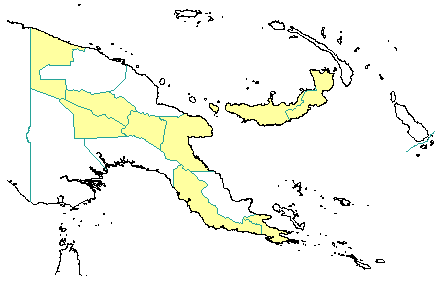
in PNGplants database
PNGTrees – Daphniphyllum gracile Gage var. tuberculata Huang |
Barry Conn (NSW) & Kipiro Damas (LAE).
Copyright held by the authors, Royal Botanic Gardens and Domain Trust, and Papua New Guinea National Herbarium
Taiwania Vol. 12: 159 (1966)
Other Literature: W.R. Barker, Handbooks of the Flora of Papua New Guinea Vol. 2: 37 (1981) Fig. 12.
Field Characters: Large trees up to 20 m high or small trees. Bole cylindrical 30 cm diam.; crooked bole 5 m long; buttresses absent; spines absent; aerial roots absent; stilt roots absent. Bark brown, rough, slightly cracked, slightly pustular, or slightly fissured; lenticels elongated vertically; subrhytidome brown; bark thickness <25 mm thick, 10.0 mm thick; blaze consisting of one layer; strongly aromatic; onion-like; outer blaze pale brown, with stripes stripes brown, fibrous; inner blaze pale brown, with stripes stripes brown, fibrous; exudate present, colourless, spotty, changing colour on exposure to air, to pale brown, slightly sticky. Terminal buds not enclosed by leaves; complex hairs absent; stinging hairs absent; mature twig without hairs.
Leaves: Spaced along branches <internodes readily visible>. Leaves spiral, simple; petiole present, not winged, attached to base of leaf blade <not peltate>, not swollen; lamina equally broad throughout much of length, 4.5-10.0 cm long, 15.0-35.0 cm wide; lamina symmetric, margin entire, not dissected or lobed, apex acuminate or acute, venation pinnate <secondary veins arising from the midrib along its length>, secondary veins open <spaced far apart to easily see tertiary veins>, prominent, intramarginal veins absent; lower surface blue-green, upper surface dark green, hairs absent; oil dots absent; domatia absent; stipules absent.
Flowers: Inflorescence axillary <from between a leaf and branch>. Flowers on a branched axis; flowers unisexual, usually with male and female flowers on different plants <dioecious> or rarely with male and female flowers on the same plant <monoecious>, flowers stalked, with many planes of symmetry <actinomorphic> or slightly asymmetric, 1.0-5.0 mm long, small (< or =10 mm diam.) 3-5 mm diam.; perianth present, with all sepals and/or petals (hence tepals) similar, yellow or green; inner perianth (4-) 5 (-6), free or rarely some or partly joined; stamens 5-9 (male flowers; female flowers with 6-9 staminodes), filaments present or almost absent, free of each other, free of perianth; ovary superior <seated above petals and sepals; hypogenous>, carpels joined (when more than one) <syncarpous>, locules 2 (-4); styles solitary <including joined together> short, 1.
Fruits: Fruits arranged on branched axis. Fruit 8-15 mm long, 6.0-9.0 mm diam., fruit dark blue, black, or purple, not spiny, fleshy, simple, indehiscent, drupe. Seeds 1 (-2), not winged, longer than wide 6-8 mm long, 1-10 mm diam. 4-5 mm diam.
Distribution: Southern Highlands, New Britain, Central, Eastern Highlands, Morobe, West Sepik, Western Highlands & Milne Bay.
 | Botanical records in PNGplants database |
Notes: Two varieties of D. gracile are recognised in Papua New Guinea, namely var. gracile and var. tuberculata. The leaves of var. gracile tend to be obtuse to rounded, but mostly with a short point that is up to 1 mm long, rarely as long as 2.5 mm. Whereas, the leaves of var. tuberculata are more slender with an acute to obtuse apex with a longer point, mostly 3-25 mm long, rarely as short as 1.5 mm. The fruits of var gracile are stated as being smooth whereas those of var. tuberculata are recorded as tuberculate (bumpy) (refer W.R. Barker in Handbooks of the Flora of Papua New Guinea 2: 37, 1981). These apparent differences in fruit features may not be reliable characters for distinguishing these two varieties.
The species name for this plant is unclear. Daphniphyllum papuanum Hallier f. is either regarded as a synonym of D. gracile or D. papuanum is regarded as the accepted name with D. gracile as a synonym. Both names were published in 1918 and clearly refer to the same species. Furthermore, the distinctness of this species from D. glaucescens, a widespread species occurring to the west of the New Guinea island, requires further evaluation.